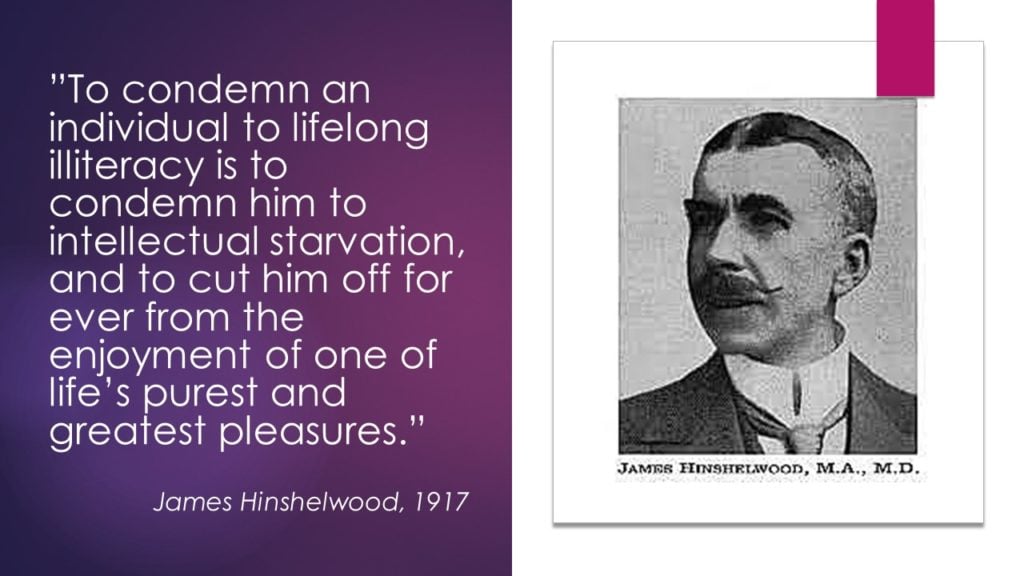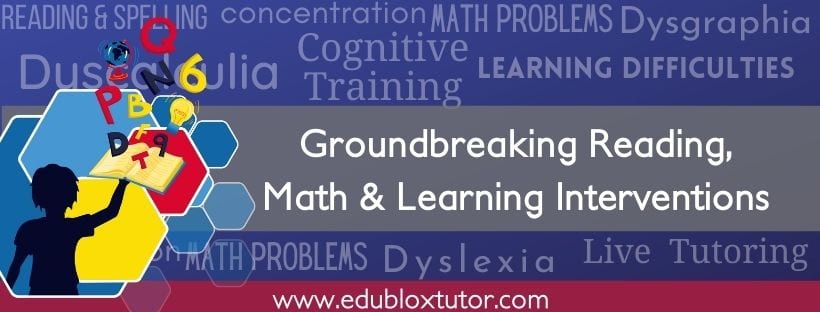
In 1907, a schoolmaster in Glasgow, Scotland, mentioned to a county Medical Officer of Health that he was “greatly puzzled” about four of his students. They were the youngest brothers in a family of eleven children and, unlike their seven siblings, had “experienced the greatest difficulties in learning to read.”
The medical officer, a former pupil of James Hinshelwood, “at once” recognized the true nature of the difficulty. He referred the boys to his former mentor to confirm the diagnosis and provide the schoolmaster with expert help (Hinshelwood, 1907, p. 1230).
Diagnosed with congenital word-blindness
Hinshelwood confirmed the medical officer’s preliminary conclusions: the boys indeed had congenital word-blindness (today called developmental dyslexia). This condition “frequently assumes a family type,” was probably hereditary, and was caused by a “faulty development” of a special cerebral area.
Hinshelwood reasoned that, because the reading problems were clustered in one family, the four boys had normal general intelligence, lacked visual problems, had good auditory memory and visual memory except for words and letters, and had a family life and school instruction that had not impeded their siblings’ learning, it was “evident that their cerebral defect was a purely local one,…that it was strictly confined to the cerebral area for the visual memory of words and letters, the left angular gyrus, and did not extend at all beyond that” (p. 1231).
Congenital word-blindness is brain-based
Four years after examining these four brothers, in 1911, Hinshelwood (1917) had the opportunity to study two members of this family’s next generation, viz., the children of the family’s eldest daughter. The mother had six children, and while she never had any difficulty learning to read, two of her children were word-blind.
Hinshelwood (1907) concluded that the root of congenital word-blindness lay in children’s brains. He deduced this after observing that dysfunctional reading symptoms found in adults with brain lesions were analogous to those of certain children with reading problems. If an inability to recognize and remember letters and words, or to unite recognizable letters into syllables or words, was acquired word-blindness, a symptom of localized brain damage in adults; and if it was clear that sensory functioning, intellectual functioning, and environmental conditions could be excluded as causes of the reading disability, and if the reading symptoms were similar to those of acquired word blindness, it was “evident” that the problem was caused by localized brain damage that was probably hereditary.
Acquired vs. congenital forms
The difference between the two classes of cases, explained by Hinshelwood in his book Congenital Word-blindness (1917), is that in acquired word-blindness, the visual memories of words and letters, the result of years of past training and education, have been completely lost. However, in the congenital form, children with otherwise normal brains and intelligence cannot acquire these visual memories of words and letters, at least through the same education and training process as other children.
Hinshelwood considered “pure” congenital word-blindness — where the defect is grave and confined to the visual memory center only in an otherwise normal and healthy brain — to be treatable through personal and systematic instruction. Instruction should be started sooner rather than later, “when the brain is most plastic, when it is most receptive of impressions and most capable of further development” (p. 97).
Hope for word-blindness
Hinshelwood even had hope for people who suffered from acquired word-blindness. He believed re-education would assist the corresponding center on the opposite side of the brain to take over the functions of the defective cerebral area. He detailed case studies of his patients who had done so.
For Hinshelwood, treatment was just as important for children of the lower classes as for those of the upper (p. 99):
The child of the rich man in most cases is spared the struggle for existence, and is provided for by his parents, but the child of the poor man has to earn his bread and push his own way in the world. To ask him to begin his career in life as an illiterate without being able to read is surely to handicap him very heavily throughout his whole existence, no matter what career he may choose. There is more to be considered than simply ‘getting on well in the world.’ Every man, rich and poor, has an intellectual side to his existence, and life would be to many a very poor thing without this. To condemn an individual to lifelong illiteracy is to condemn him to intellectual starvation, and to cut him off for ever from the enjoyment of one of life’s purest and greatest pleasures. I regard it, therefore, as a gross injustice to any child, no matter what his position in life may be, not to be taught to read, if it is possible to do so even at the cost of great trouble to all concerned.
Three stages of treatment
James Hinshelwood advocated for the “old method” of teaching reading, not the “look and say” system. The “old method” occurred in three stages:
- first, that of acquiring the visual memories of the letters of the alphabet to recognize them by sight;
- second, learning to read words by spelling them out aloud letter by letter, and so appealing to the auditory memory; and
- finally, acquiring the visual memory of words and learning to read by appealing to the visual memory center alone, i.e., reading by sight alone. When this is accomplished, the individual reads not by analyzing each word into its individual letters, but by recognizing each word as a separate picture. “Each word is regarded rather as an ideogram, picture, or symbol which suggests a particular idea. The individual now recognizes a word, just as he recognizes a landscape or a familiar face, by its general outline and form without resolving it into its constituent details,” he explained (p. 55).
Reaching the third or final stage in the art of reading is a much more formidable task and requires a much more extended time to accomplish. For the congenital word-blind to reach stage three requires great determination, patience and perseverance, and persistent repetition (p. 108):
As instruction advances it will be found as a rule that the rate of progress gradually becomes accelerated, and obstacles, which at first seemed insuperable, are gradually overcome.
.
Edublox offers cognitive training and live online tutoring to students with dyslexia, dysgraphia, dyscalculia, and other learning disabilities. Our students are in the United States, Canada, Australia, and elsewhere. Book a free consultation to discuss your child’s learning needs.
.
References:
Hinshelwood, J. (1907). Four cases of congenital word-blindness occurring in the same family. The British Medical Journal, 2(2444): 1229-32.
Hinshelwood, J. (1917). Congenital word-blindness. London: Lewis.

